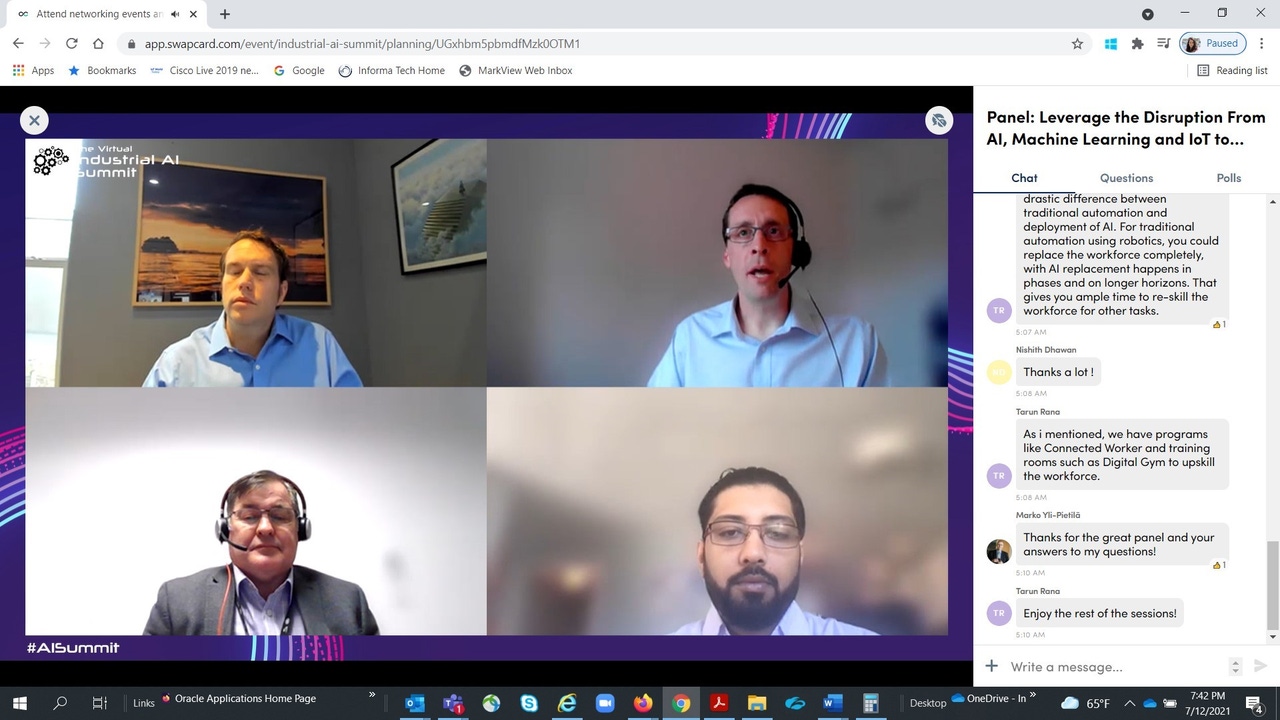Industrial AI Challenges Still PrevalentIndustrial AI Challenges Still Prevalent
Industrial AI rollouts are still immature and encountering serious challenge within enterprises. Why?
July 14, 2021

Key takeaways in this article include the following:
Industrial AI is still nascent in many enterprises, given various technology- and people-related challenges.
Companies are still struggling with basic connection of IoT sensors.
Organizations may not understand how to store data for future use in AI modeling, or they may lack the in-house expertise to make use of industrial AI.
Experts advise organizations to store data in unstructured formats to make it easier to convert for AI modeling and to perform rollouts of industrial AI in chunks to enable rollbacks that aren’t catastrophic.
It may be surprising, but the majority of manufacturing companies haven’t yet adopted artificial intelligence to make their operations more efficient.
Possibly equally surprising: Many of the manufacturers that have enlisted industrial artificial intelligence have yet to see the payback expected.
About half of projects at the proof-of-concept (POC) phase aren’t delivering, but even in later-stage projects, that percentage remains at about 50%, said Alex West, principal analyst of IoT for Omdia, during a panel discussion on AI and industrial IoT at Industrial AI Summit.
With industrial AI, manufacturers can better understand product inventory on hand in a warehouse or gain insight into the location of a truck on the road.
But many companies have yet to take the leap that would enable these kinds of efficiencies.
“Many companies are still struggling to just connect sensors and understand really what AI is and especially how to deploy it in their operations,” said West, who moderated the session.
The hype of industrial AI can make it simultaneously too alluring and unapproachable.
Panelists agreed. “AI seems to be a magic stick or a black box,” saidTarun Rana, corporate senior manager fordigital transformation at consumer goods company Henkel.
But there are serious possibilities with industrial AI, he said.
Rana said that AI has begun to help industrial environments move toward lights-out manufacturing: fully automated manufacturing, with no human intervention.
Why Industrial AI Projects Fail to Launch
But most organizations are still struggling to just present the business case to senior management.
Failure to launch industrial IoT analytics projects is also attributable to the fact that many manufacturing organizations still haven’t adopted IoT platforms to analyze their data.
Indeed, use of IIoT platforms is low but growing. Only 10% of industrial enterprises used IIoT platforms to improve factory operations in 2020, according to Gartner, which predicts the number will climb to 50% by 2025.
Another issue is that technology change can easily outpace the rate at which organizations deploy industrial AI technology.
“We are in a constant state of migration,” Rana said. “If there is a new machine learning model and … we want to implement something, we need some steady state. That could be two to three years, and by that time, the technology has totally changed. So we’re in a constant state of migration.”
Data quality and data accessibility are other obstacles with industrial AI. In some cases, data quality is too poor to feed robust algorithms; it’s the age-old “garbage-in, garbage-out” problem. But in other cases, “the big thing that’s changed is keeping … data in an unstructured enough format that they can transform that data for whatever purpose they need in the future,” Hemphill said. Sensor time-series data may not take up much storage space, but it must be in a format that can later be used to build an AI model.
Hemphill also noted that some data – video data, for example – may be too large to store. So IT may store select parts of video data that is believed to be valuable instead of the entire data set, which is too costly or bandwidth-intensive to transmit.
And, of course, technology problems can pale in comparison with the human obstacles associated with introducing industrial AI.
Selling the value to higher-ups is critical, panelists agreed.
“The way to do it is to find a good POC and explain … in business terms how [that can] improve the bottom line, the productivity,” said Keith Roberts, global data and analytics manager for global parts supply chain at Jaguar/Land Rover.
Rana agreed that
“In supply chain, there are [few data scientists] working in core supply chain on topics like … predictive maintenance or logistics,” Rana said. “The contextualization of data is not there. We had some fields and we don’t know what the data means.”
Tips for Moving From Industrial AI POCs to Production
Ultimately, panelists said, companies’ learning curve needs to mature. That education will take place alongside the maturation of silicon chip technology.
Hemphill said that part of the solution to the learning curve challenge is to make the technology “way more accessible” with AI running at the edge, where customers can buy a gateway with pre-installed software on it. “It takes all the integration hassle out of everything and at the end of the day makes the technology much more ubiquitous,” Hemphill said.
Hemphill also recommended that enterprises take a phased approach to move from POC phase to production so that changes can be rolled back in chunks if necessary.
Finally, Rana encouraged a greater acceptance of failure to encourage risk taking and adoption. “Every AI project starts with lower accuracy,” he emphasized. “There is risk it’s not performing. We should foster a culture in which failures are allowed.”
About the Author
You May Also Like

.jpg?width=700&auto=webp&quality=80&disable=upscale)
.jpg?width=700&auto=webp&quality=80&disable=upscale)
.jpg?width=300&auto=webp&quality=80&disable=upscale)


